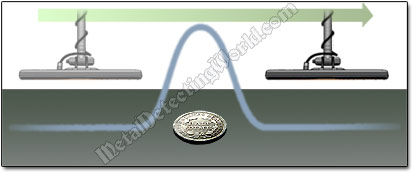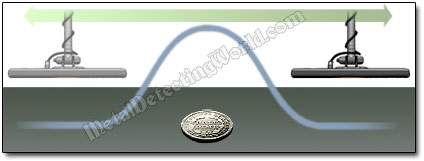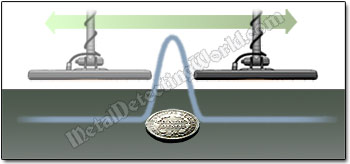Search Coils for Metal Detectors, page 13
Pinpoint Metal Detected Targets: General Information and Basic Pinpoint Modes
General Information and Basic Pinpoint Modes
Pinpointing a target refers to aligning the center of target's response width to the designated search coil center for accurate location and careful recovery of the target. Normally precise pinpointing is required on manicured lawns not to damage the grass and soil. In the wooded areas and plowed farm fields, precise pinpointing may be required only at spots with high concentration of junk.
Depending on the type and class of a metal detector, various pinpointing features may be incorporated into the non-motion all-metal mode in which Pinpointing is usually conducted (Discriminate mode is automatically disabled during pinpointing). Each detector's instruction manual includes a how-to description of pinpointing technique and explains the use of pinpointing modes.
For example, Pinpoint mode of one kind will provide a wide audio target response at the first coil sweep over a target.
Wide Audio Response

With each following sweep, it then automatically keeps the audio response narrow, but will allow targets of different depths to be pinpointed with equal precision.
Narrow Audio Response

Pinpoint mode of a different type can provide a linear audio tone: the tone pitch is proportional to the strength of the target response, and the tone volume is proportional to the depth of the target positioned under the coil. Activating Pinpoint while the coil is away from the target will allow the size of the target to be determined.
Full Audio Response

Activating Pinpoint while the coil is near the target will allow portions of the target response to be masked.
Masked Audio Response

Back in the day, to narrow the audio width of target response for defining a more accurate location of center, the technique called detuning was used. Detuning forces the electromagnetic field to become less sensitive to the target, thus reduces signal width. Today, Detuning is widely used with the up-to-date electronic pinpointers and probes for precise target location.
Many of today's metal detectors incorporate VCO (voltage controlled oscillator) into the all-metal pinpoint mode. VCO is driven by target voltage to produce varying audio pitch responses for target pinpointing and identification. Although VCO may be difficult and unpleasant to use on large shallow targets, it can be more of an advantage when multiple targets occupy the same pinpointing zone compared to monotone audio. With VCO, by narrowing the target area significantly, it is possible to hear the pitch peaks of two targets in close proximity more clearly.
If your metal detector has a continuous auto-retuning feature incorporated into the all-metal mode, you must be careful when hovering the search coil over a target. If you initiate Pinpoint while over the center of the target, the whole target may be masked as its response will be tuned out. This is why many detectorists experience "vanishing signals" in the all metal mode when attempting to pinpoint a target too quickly.